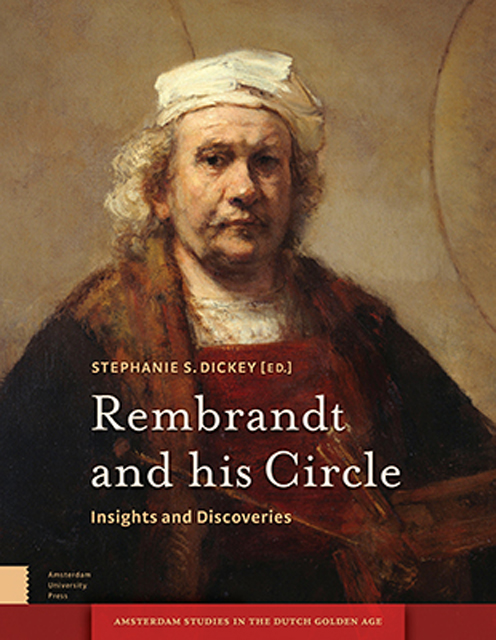Book contents
- Frontmatter
- Dedication
- Contents
- Acknowledgements
- Introduction
- 1 Rembrandt and Frans Hals Painting in the Workshop of Hendrick Uylenburgh
- 2 Rembrandt and the Germanic Style
- 3 Rembrandt and the Humanist Ideal of the Universal Painter
- 4 Curiosity and Desire: Rembrandt’s Collection as Historiographic Barometer
- 5 Painted Landscapes by Lievens and Rembrandt : The View from Seventeenth-Century Amsterdam Collections
- 6 Jan Lievens in Antwerp: Three Rediscovered Works
- 7 Gerrit Dou as a Pupil of Rembrandt
- 8 A New Painting by Jan van Noordt in Budapest
- 9 Rembrandt’s First Nude? The Recent Analysis of Susanna and the Elders from Rembrandt’s Workshop
- 10 Rembrandt’s Head of Christ: Some Technical Observations concerning Matters of Style
- 11 A Rediscovered Head of John the Baptist on a Platter from Rembrandt’s Studio
- 12 Rembrandt’s One Guilder Print: Value and Invention in ‘the most beautiful [print] that ever came from the burin of this Master’
- 13 Rembrandt, Ferdinand Bol, and Tobit: The Emergence of a Pathosträger
- 14 Biblical Iconography in the Graphic Work of Rembrandt’s Circle
- 15 Jan van Vliet and Rembrandt van Rijn: Their Collaboration Reassessed
- 16 Printmaking among Artists of the Rembrandt School
- 17 Chain Line Pattern Matching and Rembrandt’s Prints
- List of Illustrations
- Bibliography
- Index Nominum
12 - Rembrandt’s One Guilder Print: Value and Invention in ‘the most beautiful [print] that ever came from the burin of this Master’
Published online by Cambridge University Press: 21 January 2023
- Frontmatter
- Dedication
- Contents
- Acknowledgements
- Introduction
- 1 Rembrandt and Frans Hals Painting in the Workshop of Hendrick Uylenburgh
- 2 Rembrandt and the Germanic Style
- 3 Rembrandt and the Humanist Ideal of the Universal Painter
- 4 Curiosity and Desire: Rembrandt’s Collection as Historiographic Barometer
- 5 Painted Landscapes by Lievens and Rembrandt : The View from Seventeenth-Century Amsterdam Collections
- 6 Jan Lievens in Antwerp: Three Rediscovered Works
- 7 Gerrit Dou as a Pupil of Rembrandt
- 8 A New Painting by Jan van Noordt in Budapest
- 9 Rembrandt’s First Nude? The Recent Analysis of Susanna and the Elders from Rembrandt’s Workshop
- 10 Rembrandt’s Head of Christ: Some Technical Observations concerning Matters of Style
- 11 A Rediscovered Head of John the Baptist on a Platter from Rembrandt’s Studio
- 12 Rembrandt’s One Guilder Print: Value and Invention in ‘the most beautiful [print] that ever came from the burin of this Master’
- 13 Rembrandt, Ferdinand Bol, and Tobit: The Emergence of a Pathosträger
- 14 Biblical Iconography in the Graphic Work of Rembrandt’s Circle
- 15 Jan van Vliet and Rembrandt van Rijn: Their Collaboration Reassessed
- 16 Printmaking among Artists of the Rembrandt School
- 17 Chain Line Pattern Matching and Rembrandt’s Prints
- List of Illustrations
- Bibliography
- Index Nominum
Summary
Abstract
This essay explores how Rembrandt's Hundred Guilder Print was conceived to rival and surpass illustrious inventions by Raphael and Leonardo, and to be equated in value with prints after Raphael. Rembrandt surrounded a central group of Christ blessing the children with apostles, Pharisees, and other figures from Matthew 13 in an unprecedented, nonnarrative composition. This ensured a wide application of the print; indeed, it was copied to illustrate both Luke 6:17 and Matthew 8:16 in Melchior Kusel's Icones Biblicae of 1679. The extraordinary early reception of the print indicates that it was immediately recognized as Rembrandt's masterpiece.
Keywords: Rembrandt van Rijn, Hundred Guilder Print, Marcantonio Raimondi, Raphael, Leonardo da Vinci, Giovanni Pietro da Birago, Jesus Christ (ministry), printmaking
Among Rembrandt's most remarkable compositions is The Hundred Guilder Print, also known as Christ Healing the Sick, acquired by early collectors for prices from one to a hundred guilders (fig. 12.1 and pl. 12.1). Created to be extraordinary, the print was recognized as such as soon as it appeared. The etching combines Rembrandt's study from life, his close reading of Matthew 19 and other gospel passages, and his mastery of the medium. Over three dozen figures participate in this narrative: some are barely visible as heads but others are fully realised by age, dress, gender, and expression. The print demonstrates the range of Rembrandt's techniques in crafting the image, in biting, drypoint, burin, and burnishing; in printing the plate, Rembrandt exploited the effects of plate tone and printing supports. The nine known first state impressions are on japan paper, and early second state impressions are on japan paper or European laid paper. The impressions produced by Rembrandt himself demonstrate an exceptional attention to the printing process, especially in the use of plate tone to create subtle shadings and depth. As the plate was printed during the eighteenth century, it lost texture and was not wiped with delicacy. In these later impressions, some of Rembrandt's pentimenti, which he covered with plate tone, become more prominent. Among these are the first right foot of Christ, which became obscured by his robe, and the delineations of cloth around his right raised hand, as evident in an impression in the Museum Boijmans van Beuningen, Rotterdam.
- Type
- Chapter
- Information
- Rembrandt and his CircleInsights and Discoveries, pp. 230 - 251Publisher: Amsterdam University PressPrint publication year: 2017

